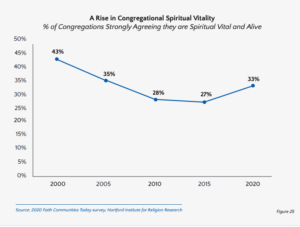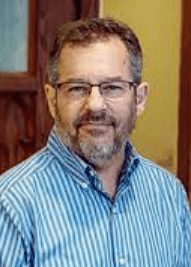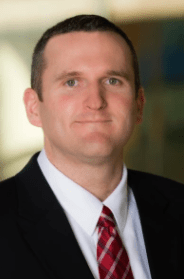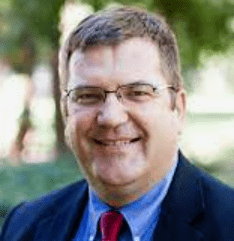After tracking a 20-year decline in American congregational vitality, researchers say they have documented a recent increase in the number of congregations that say they have resilience and are willing to embrace change and engage in their communities.
And no, the trend wasn’t true only for megachurches and other large congregations, sociologist of religion Scott Thumma said during a Jan. 25 webinar titled “Facing the FACTs: What a Survey of 15,000 Faith Communities Says About Congregational Health.”

Scott Thumma
“It does matter about size, but in fact there is a group of congregations, no matter what the size, that have vitality,” said Thumma, director of the Hartford Institute for Religion Research and co-chair of Faith Communities Today.
Thumma presented highlights from “Twenty Years of Congregational Change: The 2020 Faith Communities Today Overview.” His presentation was followed by updates from Christian and Jewish denominational representatives on how the research relates to their organizations.
Spiritual vitality
“Spiritual vitality” is defined by a congregation’s self-assessment of how well the phrase “spiritually vital and alive” describes them. FACT researchers have documented that this self-assessment tends to align well with other measures of vitality.
The six-percentage-point increase in spiritual vitality — from 27% in 2015 to 33% in 2020 — is significant because the measure indicates the presence of strong leadership, community engagement, vibrant worship and compelling vision and mission, Thumma said.

And it was accompanied by a corresponding openness to change, which declined from 74% to 62% from 2005 to 2015 before bouncing up to 73% in 2020, according to the project that surveyed 15,278 U.S. congregations. Subsequent research has documented an increase in willingness to change to above 80% during the coronavirus outbreak, Thumma said. “In some sense, the pandemic has caused all congregations to think about how to change and risk that change.”
Other positive trends
The survey also found that 77% of congregations describe their worship as “thought-provoking” while 64% described their services as “reverent” and 24% as “innovative.”
Researchers also found religious groups doing a significant service in creating social support networks in their communities, he said, with 17% hosting other congregations, 24% housing nonprofits and 20% welcoming support groups. Social justice ministries are operated by 30% of congregations.
The survey also found a continued increase in the share of U.S. congregations that are multiracial, defined as those with 20% or more participants who make up the racial or ethnic minority of the religious community, Thumma said. Measured at 12% in 2000, the percentage jumped to 24% in 2015 and to 25% in 2020.
Areas of concern
But there is plenty to be concerned about in the study, he added, including data showing that the number of small churches continues to increase as does the size of the nation’s largest congregations.
“In the past 20 years of this survey effort, the median attendance size has decreased by over 50%, from 137 to 65 attendees in weekly worship services.”
“There is a significant number of small congregations in the American religious landscape, but that large number of congregations have relatively few people in them,” he explained.
In 2000, the study found 45% of American congregations had 100 or fewer people in worship attendance. That figure rose to 49% in 2010, 58% in 2015 and 65% in 2020.
“In the past 20 years of this survey effort, the median attendance size has decreased by over 50%, from 137 to 65 attendees in weekly worship services,” the report explained. “This means that at least 175,000 faith communities (half of 350,000) in the country have 65 or fewer people in attendance on any given weekend.”
Thumma also noted that fewer congregations are growing, down from 53% in 2000 to 34% in 2020.
The survey found that “the median rate of change between 2015 and 2020 was a negative 7%, meaning half of all congregations declined in attendance by at least 7%. This is the first time in 20 years of surveys that the median five-year rate of change in attendance was negative.”
While 23% of congregations reported growth in 2020, researchers found size was a factor in predicting growth.
“Two-thirds of the congregations in the 50-or-under attendance group experienced a decline of 5% or more,” the report explains. “Those communities between 51 and 250 in size had roughly equal percentages of congregations that grew and declined. For those with weekly attendance greater than 250, the percentage of growing faith communities outpaced those that were shrinking. But it was not until worship attendance reached 1,500 or larger that a majority (71%) of congregations in that size grouping were growing during the five-year period.”
Denominational perspectives
The webinar also featured denominational researchers who briefly shared how their institutions are faring with the trends presented in the study.

Erica Dollhopf
Erica Dollhopf, director of the center for analytics, research and development for the United Church of Christ, said the mean worship attendance in UCC congregations is 67 with 17% of congregations sharing their buildings with other congregations.
The concept of vitality is a moving target, she said. “Congregations should consider how they are connected with themselves, God and the world for vitality.”

Mike McMullen
Mike McMullen, professor of sociology at the University of Houston-Clear Lake and lead researcher for the Baha’i faith, said that tradition’s average attendance is 18 mainly because most Baha’i worship in each other’s homes.

Aaron Spiegel
Rabbi Aaron Spiegel, president of the Synagogue Studies Institute, said 40% of Jewish synagogues are growing, 40% are shrinking and 20% are holding steady and “a number are closing and merging.”
One of their challenges is attracting young people or even desiring to do so, with 55% of Jewish congregations saying they place no emphasis on young people and 38% saying they place some emphasis on it. Often this is because synagogues are located in affluent areas where young adults cannot afford housing, Spiegel said.

Jonathon Wiggins
Jonathon Wiggins, director of parish surveys for the Center for Applied Research in the Apostolate at Georgetown University, said immigration and migration have contributed to Catholic growth in the U.S., where Catholicism also has undergone significant population shifts from the Northeast and Midwest to the West and South. The Catholic population in Atlanta, as an example, grew 1003% from 1980 to 2019.
Susan Barnett, director of research services for the Presbyterian Church (USA), used financial reports to describe congregational health.
Most PCUSA churches, at 34%, described their financial situations as “tight, but we manage.” That group was at 36% five years ago. Another 32% described their financial condition as “good,” compared to 35% five years ago, she said.

Greg Smith
Greg Smith, associate director of research at the Pew Research Center, commented that the Faith Communities Today data shows that American congregations are experiencing the same challenges as individuals in an increasingly secular culture. And some individuals and congregation are bucking the trends.
“While secularization is occurring, it’s still the case that most people in the U.S. identify with a religion, primarily with Christianity,” Smith said.

Gordon Mikoski
Gordon Mikoski, associate professor of Christian education at Princeton Theological Seminary and editor of Theology Today, added that the increase in the number of religiously unaffiliated Americans must be factored into congregational decline.
Generational factors also are at play, he said. “There is a loosening of commitment to institutions — at least to institutional religion — among Millennials and Gen Z.”
Related articles:
Survey says: More than half of U.S. congregations started new ministries during COVID
Largest-ever U.S. congregational survey confirms what church consultants have been telling you
Most comprehensive study yet of COVID’s impact on churches finds uneven results


